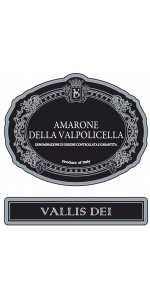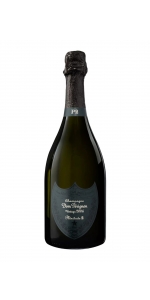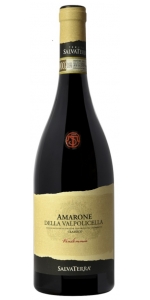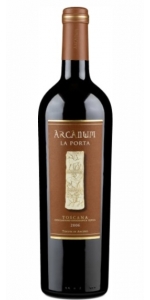Accordini Ripasso Valpolicella 2006
Bertani Valpolicella Ripasso Classico Superiore Catullo is made from 70% Corvina Veronese, 20% Corvinone, 10% Rondinella. Valpolicella Classica, Tenuta Novare Estate in Arbizzano di Negrar.
Wine of medium structure with elegant spicy notes of vanilla and chocolate accompanied by typical notes of cherry, sour cherry and white pepper. The palate offers the easy drinkability typical of Valpolicella and, at the same time, silky tannic structure and intense, prolonged aromatic persistence. The finish is fresh, soft and savory. A wine in the classic style, elegant, balanced, harmonious.
Review:
If I was forced to choose a number of wines that can steer the anachronistic Ripasso category into a brighter future, this would be among a very few. A mid-weighted, streamlined expression with just enough fruit on the bones. Think strawberries, lilacs, Asian plums, cloves and a hint of licorice. A noble, almost alpine bitterness lifts the finish. Brilliant. Drink or hold.
-James Suckling 95 Points
Cantina di Verona Amarone Valpolicella Vallis Dei is made from 65% Corvina Veronese, 30% Rondinella, 5% Molinara
Color: deep ruby red
Nose: Dried prune and blackberry with hints of vanilla and spice
Mouth: It is generously structured and velvety.
Yield: 8000 kg of grapes per hectar – after which the grapes are dried “appassimento”
Grapes are raisin-dried for at least 4 months after harvesting, losing at least 40% of their weight. It is made from selected grapes which are left to dry on racks in specially ventilated rooms until the end of winter.
Fermentation temperature between 18° and 22°C
Maceration time: 20 days
The climate in the Champagne region in 2006 was characterised by a hot, dry season, which had a significant impact on the vines. September’s summery conditions were decisive, effectively drying out the outbreaks of botrytis and encouraging exceptional ripening of the grapes. Beginning on 11 September, the harvest stretched out for almost three weeks, the ideal time for a superior-quality crop. This vintage is a perfect example of how a favourable climate can influence the champagne quality.
Dom Pérignon Vintage 2006 Plénitude 2 marks a new encounter between Dom Pérignon and the year 2006, underlining the crucial importance of time in the making of this vintage. Its persistent, suspended light offers us an invitation to contemplation, celebrating the joy of a moment of perfection. This balance between earth and sky is underpinned by a strong tactile dimension, the authentic signature of Dom Pérignon: without touch, flavour does not unfold in either the space or time of the tasting, a perfect mirror of the space and time of its production. Today, Dom Pérignon 2006 Plénitude 2 enfolds us in its warm and luminous light. It then reveals its full-bodied, substantial and curvaceous qualities, leaving in its wake the emotion of a champagne that is both enveloping and delicate.
Dom Pérignon Vintage 2006 Plénitude 2 reveals a soft, warm and reassuring sweet bouquet, rich in subtle nuances. Its aromatic profile boasts a remarkable finesse with floral and mineral tones. This composition rapidly unfolds to reveal delicate notes of wild peach, citron, calisson and mocha, creating a unique and memorable experience on the nose. The palate of Dom Pérignon 2006 is full-bodied, both restrained and tender, developing into a thick texture that gradually becomes firmer. The complexity of the wine increases, revealing a subtly saline nuance. On the finish, an exquisite bitterness and wonderful maturity prevail, enriched by deep aromas of dried fruit, cocoa and toasted hazelnut, which blend harmoniously to offer an exceptional wine tasting experience.
Dom Pérignon Vintage 2006 Plénitude 2 is distinguished by its soft, warm character, ideally expressed when paired with seafood such as langoustine and scallops. This wine pairing harmony continues with veal and Jerusalem artichoke dishes, which highlight its delicate, enveloping nature. The flavours are further enhanced by herbs such as rosemary and basil, while hints of acidity from lemon and bergamot fully reveal its breadth and refined structure. This vintage illustrates Dom Pérignon’s ability to create fine wines that capture and enhance the essence of the ingredients with which they are served.
Review:
A blonde bombshell of a Champagne, hedonistic with its alluring brioche, creamed cherry and glazed tangerine flavors that show embellishments of fragrant saffron, candied ginger, fennel seed and vanilla, yet there's lovely definition and focus via the racy, lemon-infused acidity and plush texture. Long and minerally on the finish, with the rich profile joined by a subtle undertow of smoke, oyster shell and brine. Drink now through 2040.
-Wine Spectator 98 Points
Ripa Della Volta Amarone della Valpolicella 70% Corvina, 20% Corvinone, 5% Oseleta and 5% Spigamonte.
The vineyards are located at an elevation of 300-600 metres above sea level, with a south-southwesterly exposure. Training system: Guyot.
It features an intense red color with garnet highlights. The nose offers up a rich variety of aromas with fruity notes of cherries, morello cherries and plums, spices and hints of chocolate. It is round and caressing with soft, mellow tannins balanced by excellent acidity that enhances its drinkability and ageing potential.
It is a wine with a marked personality, great finesse, elegance, and extraordinary longevity.
It pairs well with main dishes such as game and roasts, but also cured meats and mature cheese.
Review:
Strong, dark ruby with a light garnet edge. Intense and very clearly defined nose with notes of ripe plums, dark forest raspberries and some tobacco in the background. Round on the palate with plenty of supple tannin, pleasantly dry, firm pressure in the finish.
-Falstaff 92 Points
Salvaterra Amarone della Valpolicella Classico is made from 65% Corvina, 20% Corvinone, 10% Rondinella, 5% Oseleta.
Perfume of cherries, cocoa, tobacco and black pepper. On the palate it is complex and deep, elegant and robust at the same time, harmonious and with an excellent tannin.
Amarone della Valpolicella Classico is "the essence of the territory", structured but also fresh at the same time.
Pairs with red meats, aged cheese, dark chocolate, cigars.
Review:
Abundant lively red cherries, plums and mellow milk choolate with a energetic and powerful structure, an elegant frame of velvety tannins and an attractive balsamic finish.
-Decanter 96 Points
Tenuta di Arceno is a 2,500 acre estate nestled in the rolling hills of the Chianti Classico region in Tuscany.
Once an ancient Etruscan settlement, the estate has 220 acres planted under vine, leaving the rest of the land
to rolling hills of olive groves, open fields, and forests inhabited by wild boar and truffles. Arcanum La Porta
is composed entirely of Sangiovese sourced from the estate’s prized La Porta Vineyard. This single variety,
single vineyard wine holds its head high as a worthy homage to the great tradition of wine in Tuscany.
TASTING NOTES
The nose has floral tones reminiscent of rose petals, sweet plums and a hint of
cassis and vanilla. On the palate, the entrance is soft but defined by firm fresh
acidity with flavors of raspberries and our trademark flavor of the La Porta
Vineyard, candied orange peel. The finale is long with notes of cinnamon spice,
and mild cedar on the finish.
FOOD PAIRINGS
Aged Parmigiano Reggiano, Pasta Bolognese, Rack of Lamb
SERVE
Decant one to two hours before enjoying with family, friends and food
WINE STATISTICS
composition: 100% Sangiovese
alcohol: 14.0%
aging: French oak - 12 months
total acidity: 5.1 g/l
ph: 3.59 g/l
bottles produced: 19,464 (3,244 six packs)
Cellar Release
60% Corvina, 20% Rondinella, 20% Corvinoni. The vines come from the Pedemonte Hills.
Late harvest style Corvina aged on Amarone lees.
The must of Amarone remains in the vat and instead of being pressed, it is topped up with high quality Valpolicella before being left to referment for about 10-15 days.
Intense red color with garnet hints. Almond and fresh walnut aromas. Full-bodied with a good structure.
This is an excellent red wine with a supple body. The techniques used to produce this wine is typical from the area.
Pairs well with roasted meats.
review for the 2004 vintage:
"The Accordini Ripassa is a deep dark ruby blend of 60% Corvina, 20% Rondinella and 20% Corvinoni aged on Amarone lees. Amarone must is topped up with Valpolicella. The result is an exotique, beautifully balanced wine with a lovely nose of black pepper, blueberry, and dark plum with a soft, lush attack. It is youthful and fresh with a beautiful, exotically flavored, rich and juicy palate showing flavors of coffee, dark plum, black pepper that finishes with good tannic grip."
- I-Winereview (Italian Selections 2008-9), 92 pts
The Accordini Winery
The Accordini Winery is settled in the heart of the classic Valpolicella, Pedemonte. The estate is approximately 25 hectares in Negrar. The Accordini Winery focuses on three varietals: Corvina, Rossignola, Rondinella, Corvinoni, Garganega. The focus is the Ripassa style and Corvina grape, where Accordini dominates.
Guido Accordini, the family’s third generation winemaker, wanted to make the winery a leader in high quality wines production. Guido’s father built a new cellar for this high quality production. Here the most famous “Amarone” was made.
"A tiny Amarone producer of impeccable quality; the Le Bessole bottling has traditional spice, earth notes, and deep fruit; the Riserva is tannic; most of the wines offer elegance and food-friendly acidity."
- Anthony Dias Blue's pocket guide to wine 2006
Some wines from the Accordini Winery:
- Accordini, Valpolicella, Classico Superiore, Le Bessole
- Accordini, Ripasso, Valpolicella
- Accordini, Amarone, Le Bessole, Classico
- Accordini, Amarone, Riserva "Le Viole"
- Accordini, Amarone, Riserva
- Accordini, Recioto della Valpolicella, Late Harvest
Any Accordini wines we have in stock are listed below, if you don’t see the wine you are looking for please don’t hesitate to ask for it.
- back
Alain Jaume Gigondas Terrasses de Montmirail is made from 65% Grenache the rest Syrah, Mourvèdre by less than 15%.
Deep red garnet color. Aromas of ripe and black fruits. On the palate the wine is rich, powerful and harmonious - well balanced with wild berry and pepper dominating.
Soil types
Located in and around the famous area called “Dentelles de Montmirail”, the landscape typicity is made by a rocky bar (between 100 and 600 meters high). Soils are made of clay and sand with limestone. The “Dentelles” appeared thanks to the pressure between the Pyrenees and Alps mountains. This is a land of predilection to produce both powerful and fresh wines. Nights are cooler and the grapes ripeness usually comes in late September.
Winemaking & aging
Traditional wine-making in stainless and concrete vats. Crushed and destemmed grapes. Average of 18 days of vatting with pigeages. Ageing in vats mostly and oak barrels. Bottling after 12 – 14 months.
Siegel San Elias Carmenere is made from 100 percent Carmenere.
The nose shows beautiful red and dark fruit aromas, earthy notes and violets with balanced acidity. Supple and round in the mouth, juicy tannins, good concentration.
Pairs well with pasta dishes, Mediterranean cuisine and grilled vegetables.











